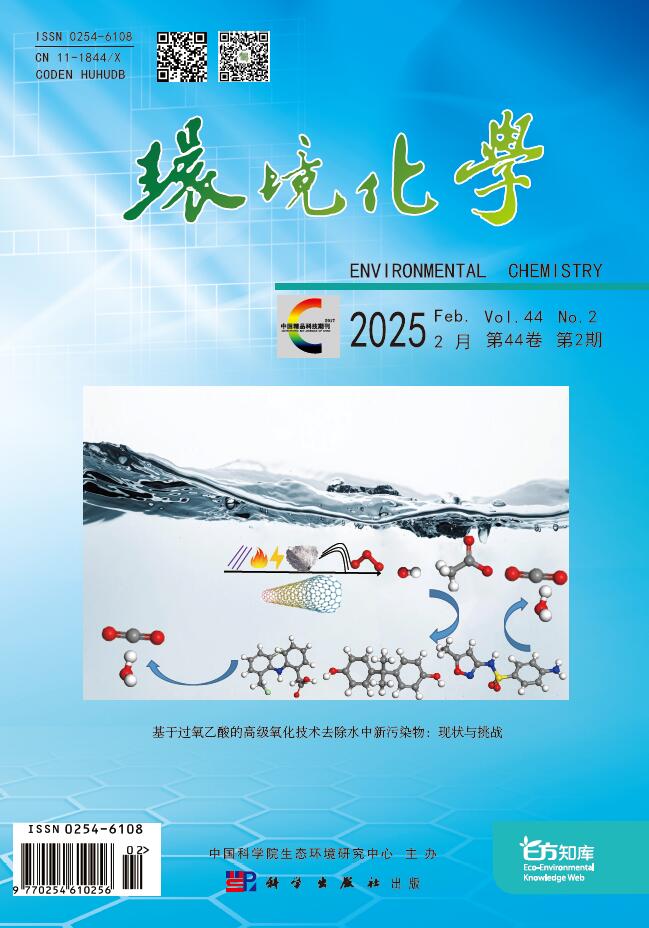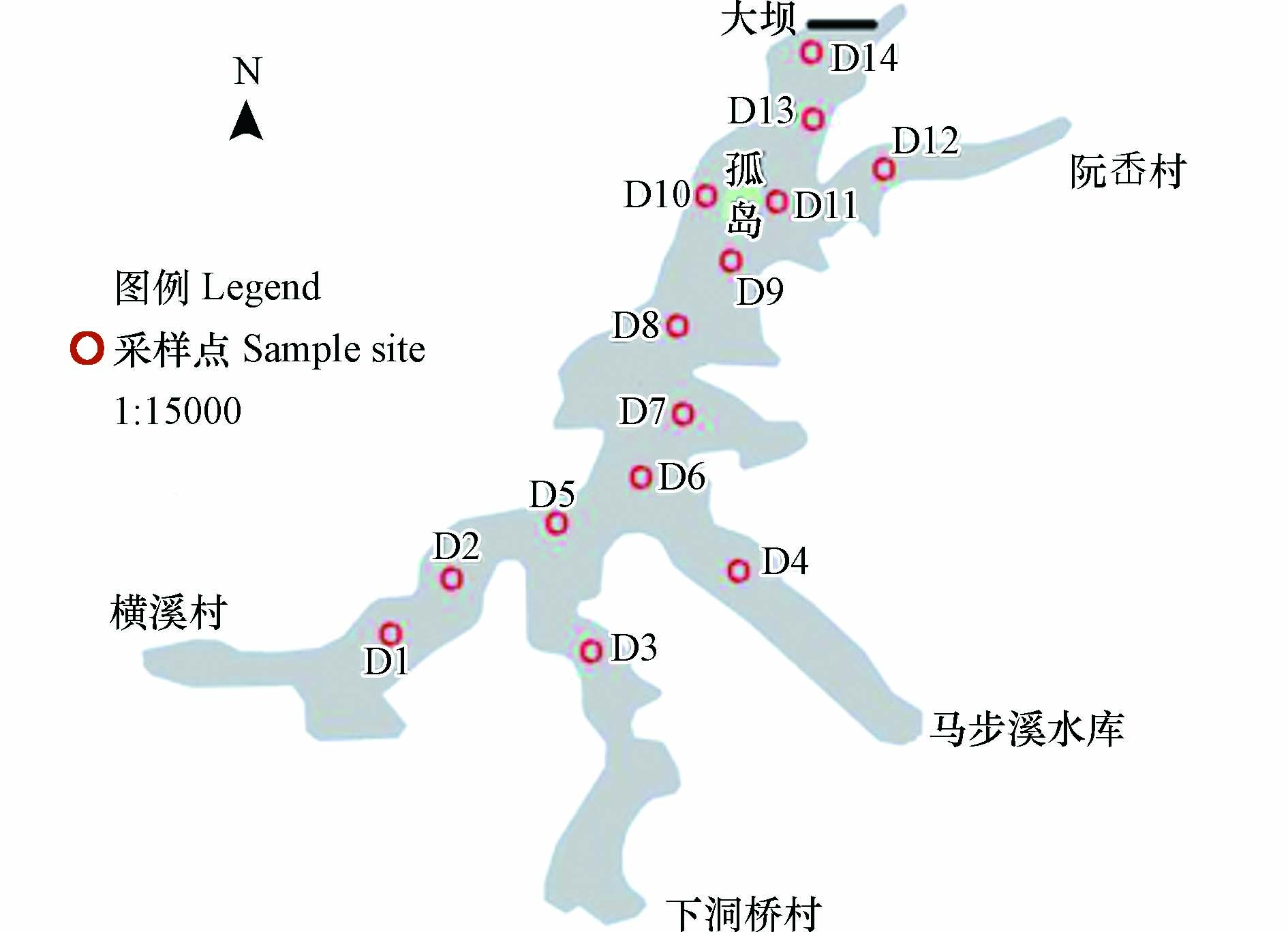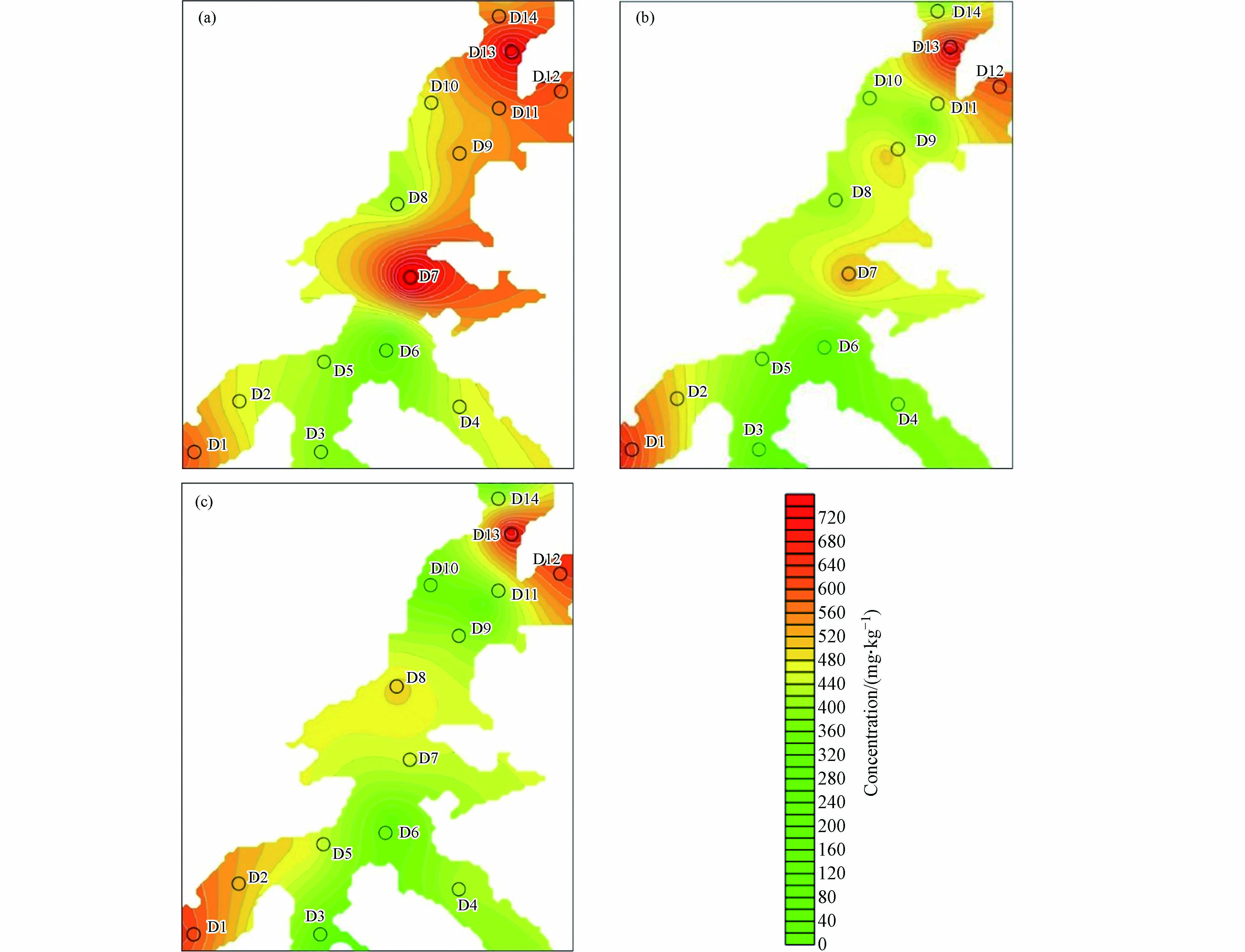-
水体富营养化会带来水华、嗅味、水生生态系统恶化等问题,是目前水库面临的最主要的挑战之一[1-3],随着政府部门的重视,造成水体富营养化的外源因素得到了有效的控制,但水库的内部营养负荷对水体的富营养化仍有着重要的影响[4-5]. 底泥作为内部营养元素的主要蓄积地,其营养元素的浓度水平和空间分布直接影响着水库的水质及整个水生生态系统[6]. 单宝庆等[7]采用沉积物质量准则、有机污染指数和有机氮指数对我国东部淡水流域的沉积物质量进行评价,发现沉积物受氮、磷污染严重,其质量问题亟待解决. 孙庆业等[8]采集了董铺水库沉积物样本,通过计算氮磷综合污染指数和有机污染指数发现评价库区有88.9%的河流断面沉积物属于清洁-中度污染. 黄廷林等[9]通过TOC、TN、TP之间的相互关系,推测出纤维束植物碎屑是周村水库沉积物有机质的主要来源. 水库沉积物作为水体营养元素污染重要的汇与源[10],通过分析其中营养元素含量及生态风险评价,对保障水库供水安全和生态系统修复有重要的指导意义[11].
湖漫水库是温岭市最大的集中式饮用水源水库,是温岭市区和周边石桥镇、城南镇、箬横镇、松门镇等区域的饮用水水源,供应20余万市民生活用水[12],同时担负防洪、灌溉、养殖等作用[13]. 鉴于湖漫水库在浙江省温岭市重要地位,本文率先研究营养盐垂向分布特征与生态风险评价,一方面填补水库建成后沉淀淤积引起营养盐空间变化规律空白;另一方面为考察蓝雪春等[14-15]指出湖漫水库自2011—2019年水质富营养化状态逐年升高是否与内源污染关联性;同时为政府管理部门对水库清淤底泥处置[16]与清淤经费估算等决策提供基础性依据.
本研究采集湖漫水库表、中、底层沉积物,测定其中TP、TN、TOC含量,分析营养元素分布特征;并采用沉积物质量准则、综合污染指数、有机污染指数和有机氮指数评价水库沉积物的生态风险等级;最后通过营养元素之间的相关性分析,探究主要污染来源.
-
湖漫水库(28°30´,121°40´)位于浙江省温岭市,总库容达3503万m3,集水面积为32.48 km2[15]. 库区两岸土地以林业用地为主,支流两岸土地以居民用地和农业用地为主. 结合湖漫水库库区形态、支流、水动力等综合因素,在库区、大坝附近和4条支流(横溪村、下洞桥村、马步溪水库、阮岙村)共设置14个采样点,采样点具体分布、经纬度、所属区域如图1和表1所示.
-
于2018年3月采用奥地利产UWITEC柱状采泥器采集沉积物样品,将采集后的样品迅速运往实验室. 依据文献[17]采用拐点法确定底泥环保疏浚最适合深度多为20—40 cm,综合考虑《土壤环境监测技术规范》所规定取样质量要求,本研究以20 cm间隔将沉积物分为表层(0—20 cm)、中层(20—40 cm)和底层(40—60 cm). 将采集的沉积物样品置于风干盘中,摊成2—3 cm的薄层. 风干后,用球磨仪进行研磨,采用四分法将样品通过60、100目土壤筛,备用. TP采用碱熔-钼锑抗分光光度法(HJ 632—2011)测定;TN采用凯氏法(HJ 717—2014)测定;TOC的测定方法为燃烧氧化-非分散红外法(HJ 695—2014).
-
本文对沉积物的生态风险评价主要有环境质量评价指南分析和综合污染指数[9]、有机指数、有机氮指数[7]分析. 其中环境质量评价指南分析参考加拿大安大略省环境和能源部1992 年制定的沉积物环境质量评价指南(表2),根据沉积物中的污染物对底栖生物的生态毒性效将沉积物分为安全级、最低级和严重级3个级别[18]. 综合污染指数、有机指数和有机氮指数计算公式如下:
单因子污染指数:
$ S_{i}=C_{i} / C_{s} $ 综合污染指数:
$ F F=\sqrt{\dfrac{S^{2}+S_{\max }^{2}}{2}} $ 有机指数:OPI=TOC(%)×TN(%)×0.95
有机氮指数:ONI=TN(%)×0.95
式中,Ci为评价因子实测值,Cs为评价因子的评价标准含量;S为评价因子的评价指数平均值,Smax为最大单项评价指数.
沉积物综合污染程度分级标准详见表3;有机指数和有机氮指数评价分级标准详见表4. 本文采用Sufer软件对营养元素的空间分布进行绘图,营养元素的相关性采用SPSS进行计算.
-
湖漫水库库区表、中、底层沉积物中的TP含量空间分布分别如图2所示,库区表层沉积物中TP含量范围为272—785 mg·kg−1,平均值为516.43 mg·kg−1. 由图2(a)可以看出,表层沉积物中TP含量较高的区域集中在大坝附近、库区中心及阮岙村、横溪村两个支流处,分别对应的采样点为D14、D7、D12、D1,TP含量分别为523、785、590、616 mg·kg−1. 如表5所示,与我国其他水库沉积物TP含量相比,湖漫水库沉积物中的TP浓度处于中低水平,远低于太湖(1150 mg·kg−1)、三峡水库(1014 mg·kg−1)[19],略高于浙江省长潭水库(430 mg·kg−1)[20]. 中层和底层沉积物中TP含量范围分别为233—710 mg·kg−1、201—623 mg·kg−1,平均含量为450.71 mg·kg−1、359.29 mg·kg−1. 在大坝附近、阮岙村支流和横溪村支流处中层和底层沉积物的TP含量均较高,其中大坝附近D14的中层和底层沉积物中TP含量分别为363、266 mg·kg−1,阮岙村支流的中层和底层淤泥中TP含量分别603、577 mg·kg−1,横溪村支流的中层和底层淤泥中TP含量分别663、572 mg·kg−1. 对比图2,不难发现湖漫水库沉积物的TP含量大小顺序为:表层>中层>底层,这与前人的研究结果一致[21-22]. 表层与中、底层沉积物的TP浓度空间分布规律略有不同,库心区域仅表层沉积物的TP含量较高,中、底层沉积物的TP含量明显减小.
-
图3分别表示湖漫水库表、中、底层沉积物中TN含量的空间分布图. 由图3(a)可得,表层沉积物中TN含量的空间分布差异较为明显,TN浓度范围在623—2510 mg·kg−1,平均浓度为1690 mg·kg−1. 与我国其他水库相比(表5),TN浓度处于中等水平,略高于长潭水库(1460 mg·kg−1)[20]. 高TN含量集中在大坝附近、库心及阮岙村、横溪村支流处,分别为2030、2070、2460、2510 mg·kg−1. 大坝附近和库心的高浓度TN分布与前人的研究结果一致[23]. 参照美国环境保护部标准[24],可以判定湖漫水库表层沉积物为氮元素为中度污染. 由图3(b)可以看出,仅大坝附近的中层沉积物TN含量较高,为2770 mg·kg−1. 而大坝附近和阮岙村、横溪村两支流处的底层沉积物TN含量均很较低. 对比图3发现,随着深度的增加,沉积物中的TN含量明显下降.
-
湖漫水库表、中、底层沉积物中TOC的空间分布如图4所示. 与TP、TN浓度空间分布规律相似,大坝附近、库区中间及阮岙村、横溪村支流处的沉积物TOC含量较高,百分含量分别为:1.61%、1.81%、1.53%、1.64%. 库区表层沉积物的平均TOC含量为1.28%,与我国其他水库相比,处于中低水平[25]. 对比图4可以明显看出,随着深度的增加,沉积物中的TOC含量呈逐渐下降的趋势,可能的原因是水生生物的排泄物及残骸逐渐在表层沉积物中积累. 大坝附近和库区中间处沉积物的TOC含量随深度变化较为显著,底层TOC仅为表层TOC的43.5%.
综上所述,湖漫水库表层沉积物中的TP、TN、TOC均存在明显的空间差异性,高营养元素含量主要集中于大坝、库心及阮岙村、横溪村支流区域. 随着深度的增加,沉积物中的营养元素呈下降趋势,底层沉积物中TP含量为表层的77%,TN和TOC余约为表层的62%. 此外,相比大坝附近和阮岙村、横溪村支流区域,库心的营养元素随沉积物深度的增加下降趋势更明显.
-
参考2.1节的分析结果,本节仅对湖漫水库的表层沉积物进行生态风险评价. 首先,参考加拿大安大略省环境和能源部(1992年) 制定的沉积物环境质量评价指南,分析沉积物中污染物对底栖生物造成的生态毒性效应. 湖漫水库79%的表层沉积物TP浓度小于600 mg·kg−1,仅D1、D7、D13处的TP大于600 mg·kg−1,表明湖漫水库大部分区域TP的生态毒性处于安全级别,极少部分为最低级. 库区表层沉积物的TN浓度较高,最低值为623 mg·kg−1,最高值为2510 mg·kg−1,TN浓度范围介于生态安全毒性最低级别浓度范围内(550—4800 mg·kg−1). 库区大部分区域表层沉积物TOC的含量介于10—100 mg·g−1,即生态毒性处于最低级别;仅D3、D4、D5、D6处沉积物的TOC含量小于10 mg·g−1,生态毒性处于安全级别. 由此可见,湖漫水库的营养元素污染对底栖生物存在最低级的生态毒性效应,主要来源于氮和有机质.
计算14处采样点表层沉积物的综合污染指数,结果如表6所示. 根据沉积物综合污染评价标准[9,34],将14处采样点表层沉积物的氮、磷污染和综合污染分为4级,级数越大表明污染越严重. 由沉积物中氮的单价评价指数可以看出,14个采样点中有4级9处、3级3处、2级1处、1级1处;14个采样点的磷评价指数中有4级2处、3级9处、2级3处. 综合氮、磷污染指数,得出的综合污染指数中有4级9处、3级1处、2级3处、1级1处. 这说明湖漫水库表层沉积物中有64.3%的区域处于重度营养盐污染,有28.6%的区域处于中度及轻度污染,7.1%的区域未受污染. 此外,对比氮、磷单项污染指数和综合污染指数,由图5可以发现综合污染指数的级数受TN评价指数影响较大,表明湖漫水库的营养盐污染主要来源于氮污染.
针对库区沉积物中污染较为严重的有机质和氮,进行有机指数和有机氮指数分析[19],结果如表7所示. 参照有机氮指数的评价标准[35],发现湖漫水库表层沉积物中的有机氮指数范围为0.06—0.24,均处于中度至重度污染水平. 库区表层沉积物的有机指数范围为0.02—0.45,其中14%为几乎未被污染,64%为轻度污染,21%的部分受到中度污染.
结合沉积物质量准则、污染指数、有机指数和有机氮指数的分析,发现湖漫水库表层沉积物对底栖生物存在生态毒性,毒性级别为最低级别. 生物毒性主要来源于沉积物中氮污染,尤其是有机氮污染较为严重. 有研究表明在偏酸性和厌氧条件下,沉积物中的氮更易释放到上覆水中,从而可能会引起藻华[7]. 湖漫水库沉积物的pH范围为5.05—6.08,由此可推断氮污染严重,且存在释放风险,可能造成水库内源污染.
-
沉积物中营养元素的相关性与其附近的土地利用类型、人口密度、工农业发达程度等因素密切相关[11],水库内部的地球生物过程也对氮磷的存在形态具有重要的影响[36]. 故本节通过分析沉积物中C、N、P的相互关系以探究湖漫水库营养元素污染的主要来源.
-
表8表示的是TOC与TP、TN的相关性,可以看出,TOC与TP、TN均显著正相关(系数>0.01). 这说明沉积物中C、N、P具有同源性,且N、P以有机态存在较多[37]. TOC与TP、TN的相关系数分别为0.863、0.955,表明TOC与TN有更强的相关性. 结合表9中TOC、TP、TN的载荷系数,可以得出主成分和沉积物中营养元素的关系为:Y=0.585 TOC+0.563 TP+0.584 TN.
-
经2.1节分析,可以看出大坝附近、库区中间及阮岙村、横溪村支流的营养元素含量较高,本节主要分析D14、D7、D12、D1采样点处营养元素的比值,探究其主要污染元素及污染来源. 由N/P比可以看出,N/P比均小于7,即库区水体富营养化过程中氮质量浓度相对较低[38]. 因此,要控制库区富营养化过程,须主要控制氮的营养负荷. 有研究表明,C/N比可反应有机质来源的差异[39]. 由表10可以看出,沉积物C/N值均小于10,表明湖漫水库中外源和内源有机质基本达到平衡,属于混源有机质[7,40]. D1处的C/N比小于7,可推断此处沉积物中的有机质主要来源于浮游动物;D7、D12、D14处的C/N比分布范围为7—10,表明其有机质主要来源于浮游植物和藻类[9]. 对比表、中、底层沉积物的C/N比,发现除D1外,其他采样点处表层沉积物的C/N比均小于底层,这与前人的研究结果一致[9].
此外,C/P比可反应沉积物中有机碳和磷化合物的分解速度[35]. D1、D7、D12、D14处沉积物的C/P比值范围为20—27,表明沉积物中TOC含量较高,TP含量相对较低. 对比表、中、底、层沉积物的C/P比,发现除D7外,其他营养元素污染较严重的区域,表层沉积物的C/P比均比底层大,这可能是受大量外源有机质影响,其夹带的磷元素随有机质的沉积富集在底层沉积物中[37].
-
(1)湖漫水库沉积物中的营养元素TP、TN、TOC分布规律基本一致,均在大坝附近、库区中心及阮岙村、横溪村两个支流处浓度较高. 表层沉积物中的营养元素浓度最高,随着深度的增加,TP、TN、TOC浓度均呈下降趋势,其中库心位置的营养元素浓度下降趋势最明显.
(2)通过综合污染指数、有机指数和有机氮指数的分析,发现表层沉积物中有64.3%的区域处于重度营养盐污染,28.6%的区域处于中度及轻度污染,其余区域未受污染.
(3)沉积物中的营养盐污染主要来源于氮,尤其是有机氮的污染,并且存在释放风险.
(4)湖漫水库沉积物的营养元素污染主要来源于浮游动物、浮游植物和藻类等水生生物的排泄物及残骸在表层沉积物积累.
Distribution and risk assessment of nutrients in sediments of Human Reservoir in Wenling City, Zhejiang Province
- Received Date: 09/02/2023
- Accepted Date: 03/03/2023
- Available Online: 27/12/2023
-
Key words:
- sediment /
- eutrophication /
- distribution characteristics /
- risk assessment.
Abstract: Human reservoir is the largest drinking water reservoirs in Wenling City. It was urgent to investigate systematically the internal pollution of the reservoir in view of the increasing trend of water eutrophication. The spatial distribution characteristics of nutrient elements and ecological risk evaluation were carried out by sampling the surface, middle and bottom sediments of the reservoir and exploring the influencing factors of eutrophication, such as the contents of TP, TN, TOC. The main eutrophication sources of the reservoir were primarily investigated through the correlation between nutrient elements. The results showed that the mean concentrations of TP, TN and TOC in surface sediment were 516.43 mg·kg−1, 1690 mg·kg−1 and 1.28%, respectively. The nutrients were mainly enriched near the dam, in the center of the reservoir, and in the two tributaries of Ruanao village and Hengxi village. The nutrient concentration decreased gradually with the increase of depth. The TP content in bottom sediments was 77% of that in the surface layer, and TN and TOC contents were 62% of those in the surface sediments. Additionally, 64.3% of the surface sediments in the reservoir were seriously polluted by nutrients (especially organic nitrogen), and there was a risk of possible release. According to the correlation and ratio between nutrients, it was speculated that the nutrient pollution of sediments in this reservoir was mainly caused by the gradual accumulation of excreta and debris from aquatic organisms such as zooplankton, phytoplankton and algae on the surface sediment.










 DownLoad:
DownLoad:
